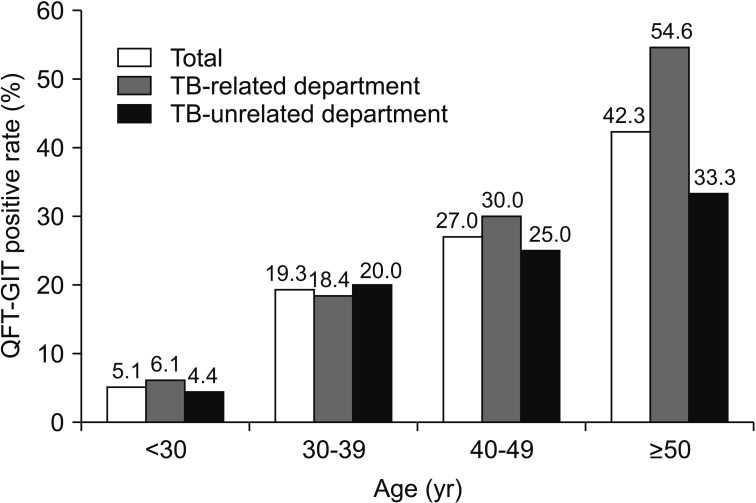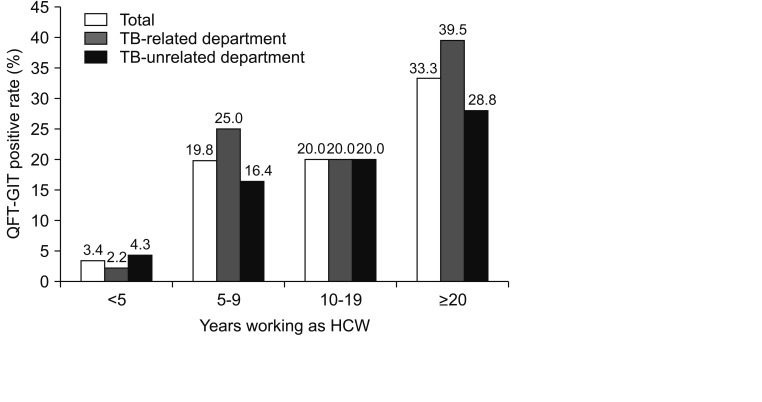The Prevalence and Risk Factors of Latent Tuberculosis Infection among Health Care Workers Working in a Tertiary Hospital in South Korea
- Affiliations
-
- 1Department of Internal Medicine, Dankook University College of Medicine, Cheonan, Korea. jspark@dankook.ac.kr
- KMID: 2420560
- DOI: http://doi.org/10.4046/trd.2018.0020
Abstract
- BACKGROUND
The risk of tuberculosis (TB) infection among health care workers (HCWs) is higher than as noted among workers in the general population. The prevalence and risk factors of TB infection among HCWs were assessed in a tertiary hospital in South Korea, resulting in a conclusion of an intermediate TB burden within the country.
METHODS
This cross-sectional study enrolled HCWs who underwent a QuantiFERON-TB Gold In-Tube (QFT-GIT) test to detect the presence of a latent TB infection (LTBI), in patients admitted to a tertiary hospital in South Korea in 2017. The departments of the hospital were divided into TB-related and TB-unrelated departments, which were based on the risk of exposure to TB patients. In this sense, the risk factors for LTBI, including current working in the TB-related departments, were analyzed.
RESULTS
In this case, a total of 499 HCWs (54 doctors, 365 nurses and 80 paramedical personnel) were enrolled in this study. The median age of the subjects was 31 years (range, 20-67 years), 428 (85.8%) were female, and 208 (41.7%) were working in the TB-related departments. The prevalence of LTBI was 15.8% based on the QFT-GIT. Additionally, the prevalence of experience of exposure to pre-treatment TB patents was higher among HCWs working in the TB-related departments, than among HCWs working in the TB-unrelated departments (78.8% vs. 61.9%, p < 0.001). However, there was no significant difference in the prevalence of LTBI between the two groups (17.3% vs. 14.8%, p=0.458). On a review of the multivariate analysis, only the factor of age was independently associated with an increased risk of LTBI (p=0.006).
CONCLUSION
Broadly speaking, the factor of age was associated with an increased risk of LTBI among the HCWs in South Korea. However, those workers current working in the TB-related departments was not associated with an increased risk of LTBI.
MeSH Terms
Figure
Cited by 4 articles
-
Prevalence and Risk Factors of Latent Tuberculosis Infection among Healthcare Workers
Sunhong Lee, Ye Li Lee, Yong Chan Kim, Eun Jin Kim, Jung Yeon Heo, Young Hwa Choi
Korean J Healthc Assoc Infect Control Prev. 2019;24(2):52-59. doi: 10.14192/kjicp.2019.24.2.52.The Infectivity of Pulmonary Tuberculosis in Korean Army Units: Evidence from Outbreak Investigations
Chang-gyo Yoon, Dong Yoon Kang, Jaehun Jung, Soo Yon Oh, Jin Beom Lee, Mi-Hyun Kim, Younsuk Seo, Hee-Jin Kim
Tuberc Respir Dis. 2019;82(4):298-305. doi: 10.4046/trd.2018.0077.Predictive Value of Positive Interferon-Gamma Release Assay for Hemodialysis Patients: A Cross-Sectional Study in a Tertiary Care Hospital in South Korea
Ye Na Kim, Jinyoung Lee, Yeonsoon Jung
Korean J Healthc Assoc Infect Control Prev. 2021;26(2):96-100. doi: 10.14192/kjicp.2021.26.2.96.A Retrospective Descriptive Study on the Status of Active Tuberculosis among Healthcare Workers in a Tertiary Hospital
YunSuk Cho, YuJin Sohn, JongHoon Hyun, YaeJee Baek, MooHyun Kim, JungHo Kim, JinYoung Ahn, SuJin Jeong, NamSu Ku, Joon-sup Yeom, JunYong Choi
Korean J Healthc Assoc Infect Control Prev. 2021;26(2):89-95. doi: 10.14192/kjicp.2021.26.2.89.
Reference
-
1. Menzies D, Joshi R, Pai M. Risk of tuberculosis infection and disease associated with work in health care settings. Int J Tuberc Lung Dis. 2007; 11:593–605. PMID: 17519089.2. Joshi R, Narang U, Zwerling A, Jain D, Jain V, Kalantri S, et al. Predictive value of latent tuberculosis tests in Indian healthcare workers: a cohort study. Eur Respir J. 2011; 38:1475–1477. PMID: 22130764.
Article3. Marks GB, Bai J, Simpson SE, Sullivan EA, Stewart GJ. Incidence of tuberculosis among a cohort of tuberculin-positive refugees in Australia: reappraising the estimates of risk. Am J Respir Crit Care Med. 2000; 162:1851–1854. PMID: 11069825.4. Jensen PA, Lambert LA, Iademarco MF, Ridzon R. CDC. Guidelines for preventing the transmission of Mycobacterium tuberculosis in health-care settings, 2005. MMWR Recomm Rep. 2005; 54:1–141.5. Lee KJ, Kang YA, Kim YM, Cho SN, Moon JW, Park MS, et al. Screening for latent tuberculosis infection in South Korean healthcare workers using a tuberculin skin test and whole blood interferon-gamma assay. Scand J Infect Dis. 2010; 42:672–678. PMID: 20482459.6. Jo KW, Hong Y, Park JS, Bae IG, Eom JS, Lee SR, et al. Prevalence of latent tuberculosis infection among health care workers in South Korea: a multicenter study. Tuberc Respir Dis. 2013; 75:18–24.
Article7. Park HY, Jeon K, Suh GY, Kwon OJ, Chung DR, Yoonchang SW, et al. Interferon-gamma release assay for tuberculosis screening of healthcare workers at a Korean tertiary hospital. Scand J Infect Dis. 2010; 42:943–945. PMID: 20936910.8. Jo KW, Woo JH, Hong Y, Choi CM, Oh YM, Lee SD, et al. Incidence of tuberculosis among health care workers at a private university hospital in South Korea. Int J Tuberc Lung Dis. 2008; 12:436–440. PMID: 18371271.9. Moon HW, Kim H, Hur M, Yun YM, Lee A. Latent tuberculosis infection screening for laboratory personnel using interferon-gamma release assay and tuberculin skin test in Korea: an intermediate incidence setting. J Clin Lab Anal. 2011; 25:382–388. PMID: 22086790.10. Korea Centers for Disease Control and Prevention. National TB elimination project [Internet]. Cheongju: Korea Centers for Disease Control and Prevention;2017. cited 2018 Feb 25. Available from: http://www.cdc.go.kr/CDC/eng/contents/CdcEngContentView.jsp?cid=74227&menuIds=HOME002-MNU0576-MNU0582.11. Hung WT, Lee SS, Sy CL, Wu KS, Chen JK, Tsai HC, et al. Prevalence of latent tuberculosis infection in BCG-vaccinated healthcare workers by using an interferon-gamma release assay and the tuberculin skin test in an intermediate tuberculosis burden country. J Microbiol Immunol Infect. 2015; 48:147–152. PMID: 24071516.
Article12. Pai M, Zwerling A, Menzies D. Systematic review: T-cell-based assays for the diagnosis of latent tuberculosis infection: an update. Ann Intern Med. 2008; 149:177–184. PMID: 18593687.
Article13. Zammarchi L, Casadei G, Strohmeyer M, Bartalesi F, Liendo C, Matteelli A, et al. A scoping review of cost-effectiveness of screening and treatment for latent tubercolosis infection in migrants from high-incidence countries. BMC Health Serv Res. 2015; 15:412. PMID: 26399233.
Article14. Lee SH. Diagnosis and treatment of latent tuberculosis infection. Tuberc Respir Dis. 2015; 78:56–63.
Article15. Kim SY, Park MS, Kim YS, Kim SK, Chang J, Kang YA. Conversion rates of an interferon-gamma release assay and the tuberculin skin test in the serial monitoring of healthcare workers. Infection. 2013; 41:511–516. PMID: 23104257.16. Yoon CG, Oh SY, Lee JB, Kim MH, Seo Y, Yang J, et al. Occupational risk of latent tuberculosis infection in health workers of 14 military hospitals. J Korean Med Sci. 2017; 32:1251–1257. PMID: 28665059.
Article17. Mirtskhulava V, Kempker R, Shields KL, Leonard MK, Tsertsvadze T, del Rio C, et al. Prevalence and risk factors for latent tuberculosis infection among health care workers in Georgia. Int J Tuberc Lung Dis. 2008; 12:513–519. PMID: 18419886.18. Drobniewski F, Balabanova Y, Zakamova E, Nikolayevskyy V, Fedorin I. Rates of latent tuberculosis in health care staff in Russia. PLoS Med. 2007; 4:e55. PMID: 17298167.
Article19. Lambert LA, Pratt RH, Armstrong LR, Haddad MB. Tuberculosis among healthcare workers, United States, 1995-2007. Infect Control Hosp Epidemiol. 2012; 33:1126–1132. PMID: 23041811.
Article20. Lee JY. Tuberculosis infection control in health-care facilities: environmental control and personal protection. Tuberc Respir Dis. 2016; 79:234–240.
Article21. Jo KW. Preventing the transmission of tuberculosis in health care settings: administrative control. Tuberc Respir Dis. 2017; 80:21–26.
Article22. Kwon Y, Kim SJ, Kim J, Kim SY, Song EM, Lee EJ, et al. Results of tuberculosis contact investigation in congregate settings in Korea, 2013. Osong Public Health Res Perspect. 2014; 5(Suppl):S30–S36. PMID: 25861578.
Article23. Belo C, Naidoo S. Prevalence and risk factors for latent tuberculosis infection among healthcare workers in Nampula Central Hospital, Mozambique. BMC Infect Dis. 2017; 17:408. PMID: 28595594.
Article24. Herrera V, Perry S, Parsonnet J, Banaei N. Clinical application and limitations of interferon-gamma release assays for the diagnosis of latent tuberculosis infection. Clin Infect Dis. 2011; 52:1031–1037. PMID: 21460320.
- Full Text Links
- Actions
-
Cited
- CITED
-
- Close
- Share
- Similar articles
-
- Analysis of Prevalence and Risk Factors for Latent Tuberculosis Infection among Healthcare Workers
- Prevalence and Risk Factors of Latent Tuberculosis Infection among Healthcare Workers Using Tuberculin Skin Test and Interferon-γ Release Assay at a Tertiary Hospital in South Korea
- Occupational Risk of Latent Tuberculosis Infection in Health Workers of 14 Military Hospitals
- Prevalence of Latent Tuberculosis Infection among Health Care Workers in South Korea: A Multicenter Study
- Diagnosis and Treatment of Latent Tuberculosis Infection in Healthcare Workers



